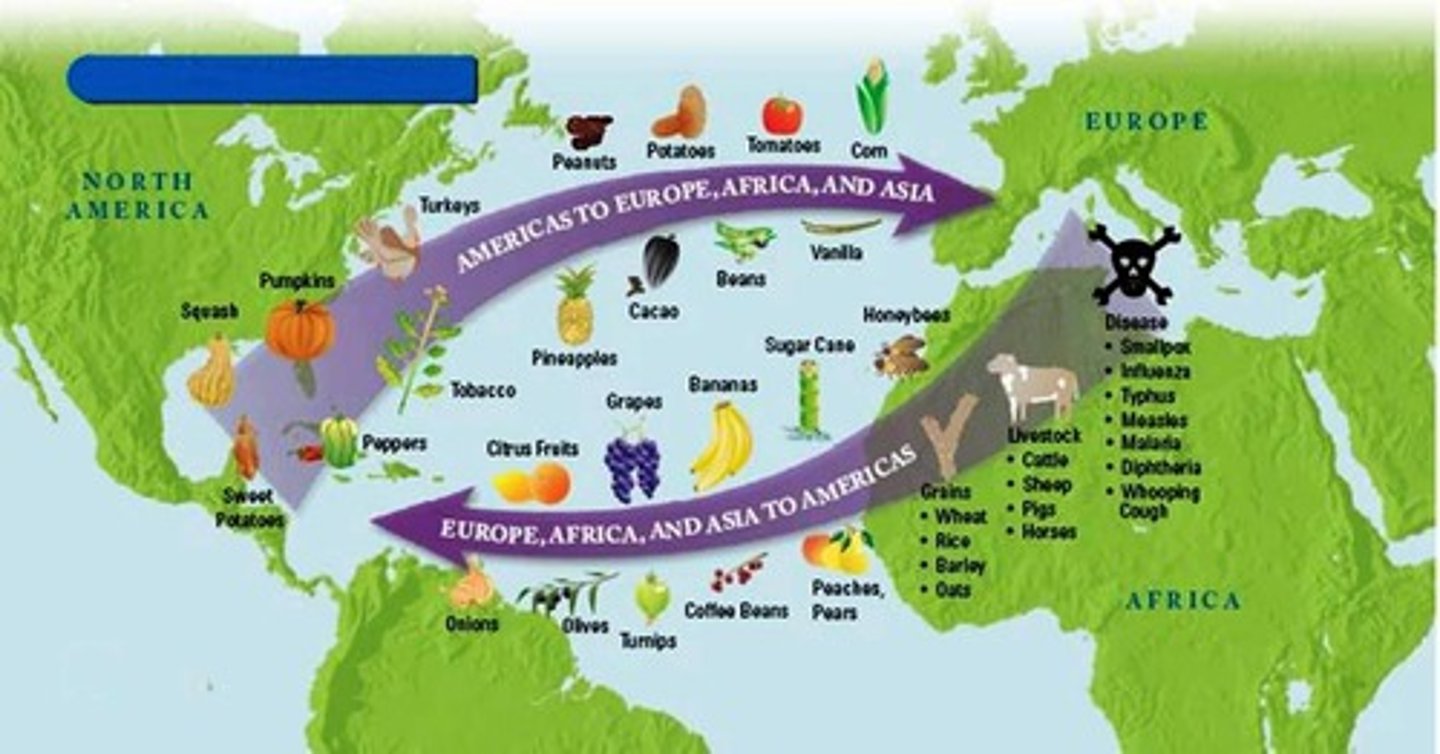European Trade Routes & Columbus
1/41
There's no tags or description
Looks like no tags are added yet.
Name | Mastery | Learn | Test | Matching | Spaced |
|---|
No study sessions yet.
42 Terms
A __________________ is total control of a type of industry by one person or one company.
monopoly
Are monopolies good for consumers?
BAD! Monopolies are not good for consumers because a company can set the price of a product to whatever it wants as there is little or no competition (ex. iPhone/Samsung)!
European began "skipping the middle man," sailing directly to Asia (=Costco=wholesaler) to buy their products at a ____________ price.
lower
Who was the "middle man" in Europe that had a monopoly on the Eurasian trade on the Silk Road?
Italy (=deli=retailer)
For purchasing goods, Europeans began " _____________ the ________________ man."
skipping the middle man
Who was the wholesaler (Costco) in the Eurasian trade routes (Silk Road).
Asia
In 1419, Prince __________ the ____________ started a school in Portugal for sailors, captains, navigators, and mapmakers.
Henry the Navigator
Who reached the Southern tip of Africa in 1487?
Bartholomew Diaz
In 1497, Vasco da Gama sailed around Africa, reaching ______________.
India
African Middle Kingdoms:
Mali, Ghana, and Songhai were at the center of the ____________ _______________ between North and West Africa.
trade routes
African Middle Kingdoms:
Mali, Ghana, and Songhai were rich in ____________, ivory, iron, and slaves.
gold
What country was the first to bring slaves to Europe?
Portugal
From 1441 to 1841, approximately _______ ______________ Africans were enslaved.
11 million
True or False: Columbus spent YEARS trying to get funding in Europe for his idea to find a shorter route to Asia.
True
What were Columbus’s 3 ships called on his first expedition?
The Nina, the Pinta, and the Santa Maria
Christopher Columbus was famous because he found something he wasn't looking for: The ___________ ____________!
New World
What year (first expedition) did “…Columbus sail the ocean blue?”
1492
Columbus was motivated by the 3Gs: _____________, ______________, & _______________.
Gold, God, & Glory
Columbus was NOT the ______________ to 'discover' or even 'explore' the Americas.
first
Columbus was the first to create extended _____________ in the Americas.
interest
In the New World, Europeans competed to _____________ these new lands, and the riches they might contain.
claim
The "New World" became a centerpiece of colonization efforts by first the _____________, and then the French, the English, and the Dutch.
Spanish
Columbus and his men killed or enslaved many of the __________ Indians found in Hispaniola.
Taino
Over time, the Taino Indians died from harsh treatment and _______________ to the point where only a few were left a hundred years later.
disease
What royal couple sponsored Columbus' voyage?
King Ferdinand & Queen Isabella
Even though Christopher Columbus was Italian, he sailed for ____________ since King Ferdinand and Queen Isabella funded his journey.
Spain
Many goods , diseases, people, plants, and animals were _________________ between the Old World (Europe) and the New World (the Americas).
exchanged
The exchange of goods, ideas, diseases, people, plants, and animals between the Old World and the New World is known as the ____________________ _____________________.
Columbian Exchange
With the Columbian Exchange, a currency/money system, sugar, farm animals/livestock (such as horses, cattle, and pigs), Christianity/Islam/Judaism, elephants, and lions belonged initially to the _________ ____________ (Europe, Africa, & Asia)
Old World

With the Columbian Exchange, tomatoes, turkeys, pumpkins/squash, tobacco, potatoes, and chocolate belonged initially to the ______ ________.
New World

Which “world” gave women more rights and had a greater respect for the environment? .
The New World
With the Columbian Exchange, diseases, slavery, and advanced civilizations existed in _________ the New and Old Worlds.
Both
Why is Christopher Columbus such an important historical figure?
Columbus' “discovery” led to the colonization of the Americas and had a lasting impact on world history.
The area that Columbus actually explored was the ________________ ________.
Caribbean Sea

When Columbus arrived in the Americas, he called the natives "Indians" even though they looked and sounded nothing like people from India
This concludes that Columbus knew virtually ______________ about the Indian culture.
nothing
The _________ of the Earth was mistaken by Columbus.
size
The Columbian Exchange was viewed as _____________, favoring Europeans; the Europeans benefited far more than the Natives.
unequal
Europe, Africa, and Asia were considered the ___________ _____________ in the Columbian Exchange.
Old World
The Americas (North and South) were considered the _____________ _____________ in the Columbian Exchange.
New World
The two staple crops of the Americas before Columbus were ______________ and ____________________.
corn and poatoes
The Natives of the Americas domesticated the ________________ and ___________________.
llama and turkey
No matter where the Europeans settled in the New World, they unknowingly brought _________ with them that wiped out large portions of the Native American populations (an estimated 90%!)
diseases (such as smallpox)